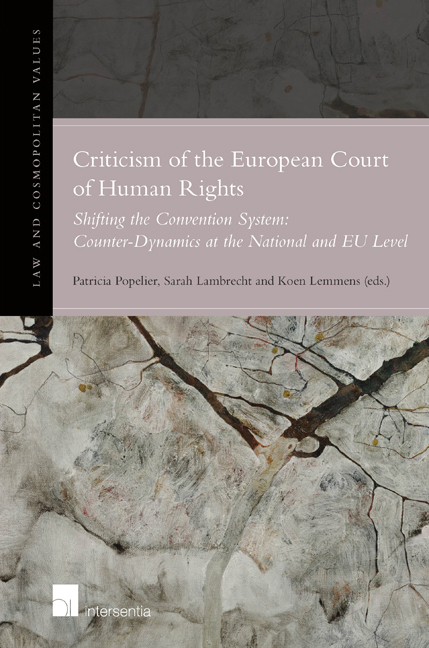 Criticism of the European Court of Human Rights
Criticism of the European Court of Human Rights Book contents
- Frontmatter
- Contents
- List of Abbreviations
- PART I INTRODUCTORY
- PART II SPARSE CRITICISM
- Chapter 4 Austria: Endorsing the Convention System, Endorsing the Constitution
- Chapter 5 Belgium: Faithful, Obedient, and Just a Little Irritated
- Chapter 6 Czech Republic: Strasbourg Case Law Undisputed
- Chapter 7 Germany: The Long Way of Integrating the Strasbourg Perspective into the Protection of Fundamental Rights
- Chapter 8 Italy: Between Constitutional Openness and Resistance
- Chapter 9 Poland: The Taming of the Shrew
- Chapter 10 Sweden: European Court of Human Rights Endorsement with Some Reservations
- PART III MODERATE CRITICISM
- PART IV STRONG CRITICISM
- PART V HOSTILE CRITICISM
- PART VI SYNTHESIS
- APPENDIX
Chapter 10 - Sweden: European Court of Human Rights Endorsement with Some Reservations
from PART II - SPARSE CRITICISM
Published online by Cambridge University Press: 13 December 2017
- Frontmatter
- Contents
- List of Abbreviations
- PART I INTRODUCTORY
- PART II SPARSE CRITICISM
- Chapter 4 Austria: Endorsing the Convention System, Endorsing the Constitution
- Chapter 5 Belgium: Faithful, Obedient, and Just a Little Irritated
- Chapter 6 Czech Republic: Strasbourg Case Law Undisputed
- Chapter 7 Germany: The Long Way of Integrating the Strasbourg Perspective into the Protection of Fundamental Rights
- Chapter 8 Italy: Between Constitutional Openness and Resistance
- Chapter 9 Poland: The Taming of the Shrew
- Chapter 10 Sweden: European Court of Human Rights Endorsement with Some Reservations
- PART III MODERATE CRITICISM
- PART IV STRONG CRITICISM
- PART V HOSTILE CRITICISM
- PART VI SYNTHESIS
- APPENDIX
Summary
CRITICISM OF THE EUROPEAN COURT OF HUMAN RIGHTS
The European Court for Human Rights (ECtHR) is rarely discussed in critical terms in Swedish media or in contemporary legal and political debate in Sweden. The limited discussion on the role of the ECtHR may be linked to the historical development of the constitutional protection of human rights in Sweden, the status of the convention, and aspects of Swedish legal culture. In this section, the development of constitutional protection of fundamental rights in Sweden is outlined, followed by a section with examples of criticism of the ECtHR.
THE DEVELOPMENT OF CONSTITUTIONAL PROTECTION OF FUNDAMENTAL RIGHTS IN SWEDEN
Ratification of the ECHR
When Sweden ratified the European Convention on Human Rights (ECHR) in 1952, the 1809 Regeringsform (Instrument of Government) was still in force. This old fundamental law had to some extent been inspired by Enlightenment ideals of protection of individuals and separation of powers. As still is the case, the Instrument of Government formed the Swedish constitution together with other fundamental laws. Far-reaching protection of the freedom of the press was set down in a special fundamental law, the Tryckfrihetsforordning (Freedom of the Press Act), tracing its origins to 1766. Apart from the provisions on the freedom of the press, fundamental rights were protected through ordinary legislation rather than constitutional law. There was no equivalent to the catalogues of rights found in constitutions dating from about the same time, eg in the USA or Norway. Furthermore, the changes in the way Sweden was governed that had taken place since the early 20th century – such as the introduction of parliamentarism and universal suffrage – were not reflected in the 1809 Instrument of Government. Later research has labelled the period ca 1920–1975 as the ‘half-a-century without a constitution’. To summarise, at this time constitutional law had a limited role in Sweden, and the status of constitutional protection of human rights was in general very weak. In spite of this, individual rights and freedoms were for the most part respected to a very high degree in Sweden through ordinary legislation and through the practice of the courts and administrative authorities.
- Type
- Chapter
- Information
- Criticism of the European Court of Human RightsShifting the Convention System: Counter-dynamics at the National and EU Level, pp. 239 - 266Publisher: IntersentiaPrint publication year: 2016
- 1
- Cited by
